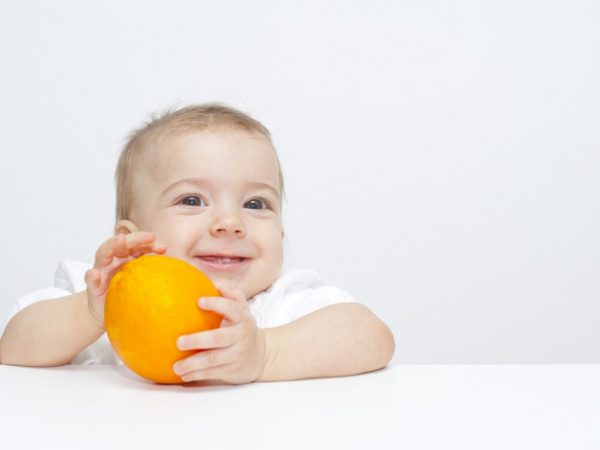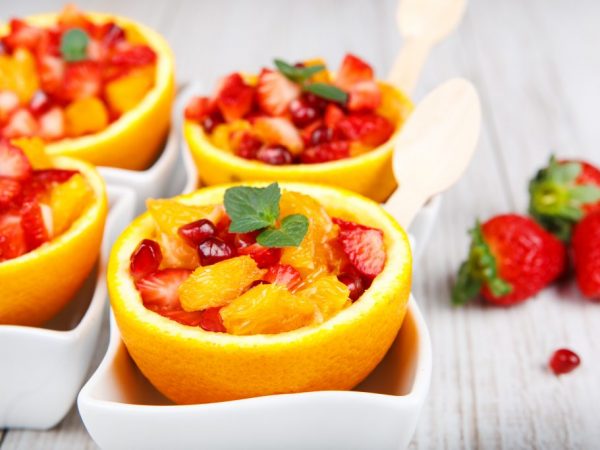Introducing orange into the child's diet
From an early age, a child gets acquainted with many new products for himself. Particular attention is paid to the variety of fresh vegetables and fruits that can cause unexpected reactions. It is important to determine how and when to introduce fresh foods into the diet, especially citrus fruits. It is required to know for certain when to give an orange to a child.

Introducing orange into the child's diet
Useful properties of an orange
Orange is a common member of the citrus group. Its fruit attracts attention with its bright color, strong aroma and sweet taste.
Citrus is rich in various chemical and biological active elements that determine its usefulness and nutritional value.
The orange contains:
- Fiber and pectin. They perform the function of cleaning the intestines from toxins, improve the digestion process. This is a good prevention of constipation, disorders. Thanks to these components, appetite increases.
- Glucose, fructose, vitamins of groups A, B, C. The high content of these nutrients supports the general condition of the body. Oranges contain higher amounts of potassium and magnesium compounds than any other citrus fruit. Phytoncides and citric acid strengthen the immune system, normalize the work of internal organs.
- Biotin. It improves carbohydrate and lipid metabolism, maintains the condition of hair, nails and skin. Orange juice is able to retain calcium in the child's body, and this trace element is necessary for the construction of the skeleton. Citric acid works as a cleaner for accumulated nitrate and nitrite compounds.
Negative consequences
Along with the benefits, oranges can have an undesirable effect on the human body.
This is especially true for children, because their body is still weak and not ready for the action of some strong and chemical-rich substances. Citrus is a strong allergen, therefore, intolerance to its components is a contraindication to its use in any form.
The high acid content negatively affects the problematic gastrointestinal tract. It is not recommended to eat orange pulp and drink juice from it for disorders such as gastritis, pancreatitis, stomach ulcer or duodenal ulcer. Diabetes mellitus is also a contraindication for eating the fruit. Acid also negatively affects tooth enamel, especially in children, softening and destroying it.
For babies, an orange is dangerous as a manifestation of a strong allergic reaction. Its manifestation is a rash, redness on the skin of the face, hands, abdomen, indigestion, swelling of the upper respiratory tract, shortness of breath. Allergies can be caused by:
- hereditary predisposition;
- autoimmune diseases;
- immaturity of the development of the intestinal tract and stomach;
- diseases of the gastrointestinal tract;
- eating oranges in large quantities during pregnancy;
- unfavorable ecology.
Sometimes a strong negative reaction to the fruit forces you to completely abandon the introduction of it into the child's diet. In this case, it is possible to replace oranges with other foods high in vitamin C: herbs, Brussels sprouts, berries. Rosehip decoction is also used as a substitute.
Orange in the child's diet

A baby can be given an orange from nine months
The introduction of citrus begins during the period of milk feeding.
- After about the 3rd month of a child's life, a nursing mother eats half of the fruit without the skin and film. After breastfeeding, she should monitor the reaction of the baby's body for the next 5 hours. If you do not see any external signs and the child does not cry because of pain in the tummy, it is allowed to use this fruit in half 1-2 times a week.
- A baby is capable of eating an orange on his own from 9 months of age. He is given a half of a wedge, peeled from skin and film. It is better to do this in the morning, after breakfast, so that there is time to track the body's reaction to the product. With a positive response, the new portion can be increased by half a lobule. There are no clear restrictions; a baby with a healthy appetite will determine the amount of treats by himself. A child is allowed to eat a whole orange at the age of 5-6 years, but not more often 2-3 times a week.
- Sometimes juice from the pulp is served, diluted with boiled chilled water in a 1: 1 ratio. Better to have it freshly squeezed and consumed after a meal. It is better to give juice for the first time in an amount of no more than ½ tsp. They also practice mixing juices: orange with carrot or apple. For children under 6 years old, juice is served in an amount of 30-50 ml, at 7-10 years old, the portion is increased to 70-100 ml.
- If the baby is diagnosed with diathesis, the introduction of the fruit is postponed until the end of the first year of life. In the presence of a strong allergic reaction in the form of asthma or dermatitis, all citrus fruits are excluded from the diet until the 3rd year of life. During the period of the first citrus sample, it is not recommended to introduce any new food in order to track the response specifically to the orange.
- The peel is used for food only after the child is 6 years old. This limitation exists for safety reasons, because the peel of any citrus is capable of accumulating harmful chemicals from the environment. Orange peel is rich in phytoncides, but it should be used carefully and in small quantities in a child's diet.
Selection of oranges for children
The most successful option for babies is sweet varieties with a slight sourness in taste.
Such oranges are most often brought from Spain, the Mediterranean, the coast of the island of Sicily. To select good quality ripe oranges, pay attention to the following:
- Fruit color ranges from orange-red to greenish. A green tint is not always a sign of immaturity. This is a sign that bright fruits have sung in a sunny area, and lighter ones - in the shade.
- The weight of the fruit is a sign of ripeness. An orange that is heavier and the same size as the rest will be ripe. A strong characteristic aroma is also the main sign of maturity.
- Usually sweet oranges are small in size. The thickness of the skin does not affect maturity and palatability, it is only a sign of the variety. Umbilical oranges (navel-shaped) are the ideal fruit for babies: they are sweet, have a lot of juice and often lack seeds.
Children's recipes with orange

For a child over three years old, you can make a salad
Citrus fruit is called a versatile product. It complements almost any dish and goes well with many other fruits and vegetables, as well as meats and cheeses. Children are served oranges peeled, film and pitted.
Orange salad
This dish is served to a child from 3 years old.This requires finely chopping several orange slices, 5 grapes, 2-3 strawberries or 4-5 raspberries, half an apple. It is better to fill the salad with yogurt or lemon juice diluted with water.
An orange salad is also prepared in another version, which includes chicken fillet or boiled fish, boiled carrots, some potatoes, and a hard-boiled chicken egg. The dressing is olive or sunflower oil, kefir, but not mayonnaise.
Orange desserts
Orange desserts are suitable for babies from 1 year old. The pulp of 2 oranges is divided into separate fibers, 2 carrots are finely grated. The ingredients are mixed together, a spoonful of raisins and sour cream are added. Served without sugar.
Another dessert is served to kids from 2 years old. To prepare it, soften 100 g of boiled pumpkin, finely chop half of the citrus, add a spoonful of yogurt or sour cream. The ingredients are mixed and added with cherry or other berry syrup.
Jam and candied fruits
Jam is given to children from 3 years old. It contains oranges: only pulp or fruits with a peel, berries and fruits, sometimes even vegetables (pumpkin, carrots). Jam, cooked in a short time on the fire, will retain more nutrients. It is often taken as the basis for homemade fruit drinks.
Candied fruits are also suitable for older children. They are made from orange peel with added sugar. For babies with diabetes or weight problems, such a product is prohibited.
Conclusion
Orange is a healthy product rich in vitamins and minerals. In this case, it is necessary to remember about the portions if children eat it. It is important to choose good quality fruits to prevent health problems in babies. If severe allergic reactions appear, they urgently consult a doctor.


